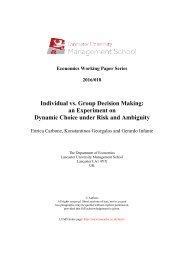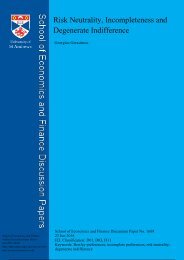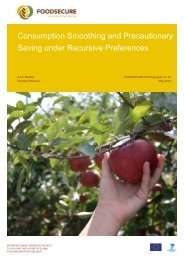Dual Random Utility Maximisation
n?u=RePEc:san:wpecon:1605&r=upt
n?u=RePEc:san:wpecon:1605&r=upt
You also want an ePaper? Increase the reach of your titles
YUMPU automatically turns print PDFs into web optimized ePapers that Google loves.
Range and Regularity (and even Constant Expansion) but is not a dRUM:<br />
{a, b, c, d} {a, b, c} {a, b, d} {a, c, d} {b, c, d} {a, b} {a, c} {a, d} {b, c} {b, d} {c, d}<br />
a 0<br />
2<br />
3<br />
1<br />
3<br />
0 −<br />
2<br />
3<br />
2<br />
3<br />
1<br />
3<br />
− − −<br />
b 0 0 0 − 0<br />
1<br />
2<br />
− −<br />
2<br />
3<br />
1<br />
3<br />
−<br />
c<br />
1<br />
3<br />
1<br />
3<br />
−<br />
1<br />
3<br />
1<br />
3<br />
−<br />
1<br />
3<br />
−<br />
1<br />
3<br />
−<br />
1<br />
3<br />
d<br />
2<br />
3<br />
−<br />
2<br />
3<br />
2<br />
3<br />
2<br />
3<br />
− −<br />
2<br />
3<br />
−<br />
2<br />
3<br />
2<br />
3<br />
Table 1: A Stochastic Choice Function that fails Negative Expansion<br />
That p is not a dRUM follows by Theorem 1 and the fact that p fails Negative Expansion<br />
(e.g. p (a, {a, b}) = 2 3 ̸= 1 3<br />
= p (a, {a, d}) while p (a, {a, b, d}) > 0).<br />
4 General dRUMs<br />
The easy inductive method we used in the proof of Theorem 1 breaks down for general<br />
dRUMs. We have to engage more directly with reconstructing the rankings from<br />
choice probabilities. The difficulty here is that, while it is clear that an alternative a<br />
being ranked above another alternative b in some ranking is revealed by the fact that<br />
removing a from a menu increases the choice probability of b, it is not self-evident<br />
in which ranking a is above b (whereas in the asymmetric case the two rankings are<br />
distinguished by the distinct probabilities α and 1 − α).<br />
If the probabilities are allowed to take on the value 1 2<br />
, then Constant Expansion is<br />
no longer a necessary property. In fact, if p (a, A) = p (a, B) = 1 2<br />
it could happen that a<br />
is top in A according to the ranking r 1 (but not according to r 2 ) and top in B according<br />
to r 2 (but not according to r 1 ). Then in A ∪ B there will be alternatives that are above a<br />
in both rankings, so that p (a, A ∪ B) = 0.<br />
The following weakening of Constant Expansion is an expansion property that circumvents<br />
the above situation and is necessary:<br />
Weak Constant Expansion: If p (a, A) = p (a, B) = α and p (a, A ∪ B) > 0 then<br />
p (a, A ∪ B) = α.<br />
13






